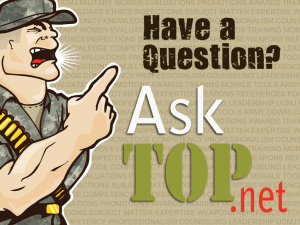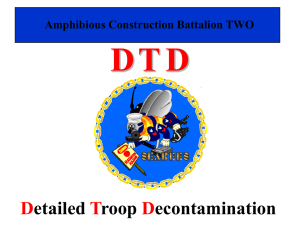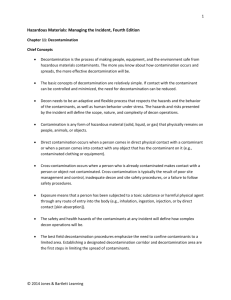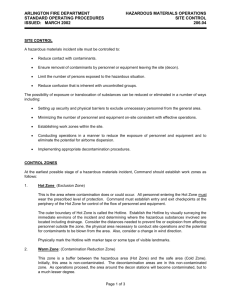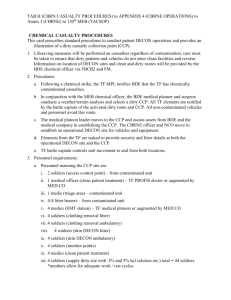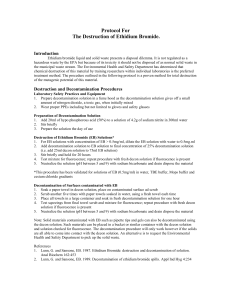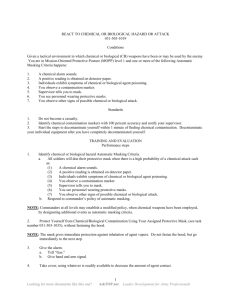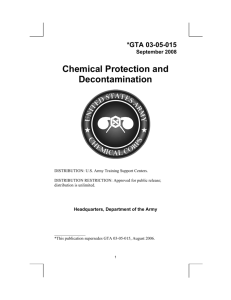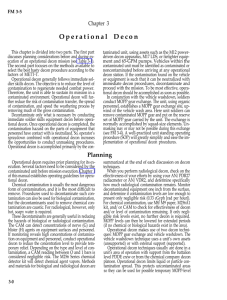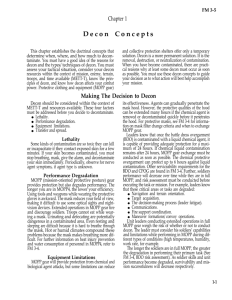CBR DETECTION
advertisement
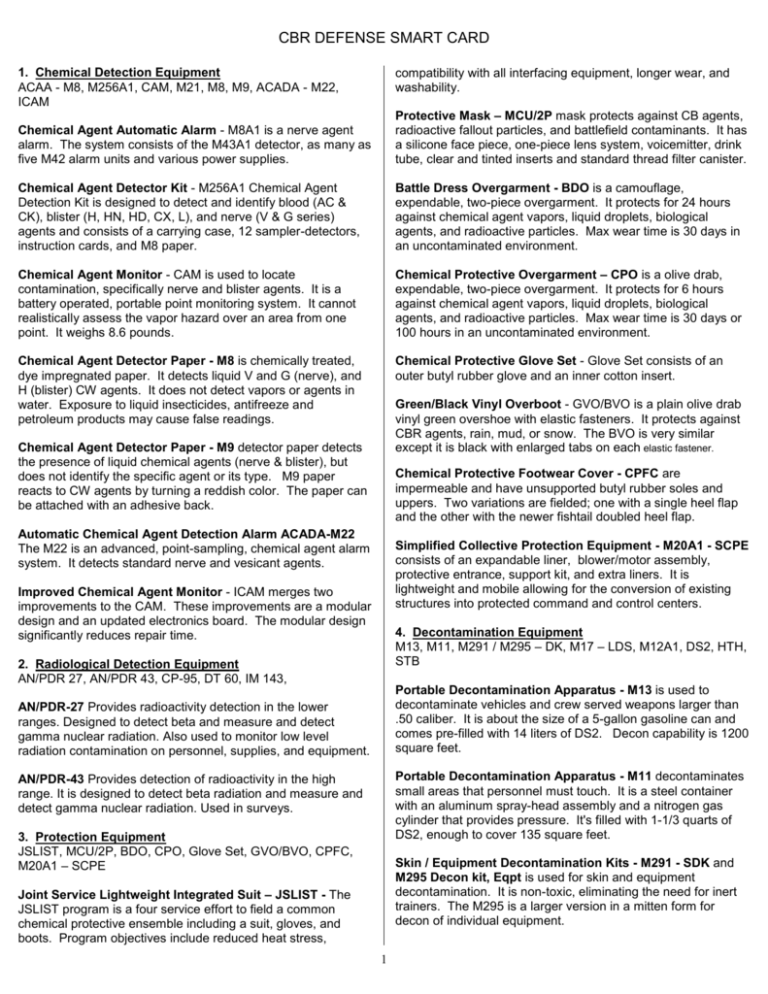
CBR DEFENSE SMART CARD 1. Chemical Detection Equipment ACAA - M8, M256A1, CAM, M21, M8, M9, ACADA - M22, ICAM compatibility with all interfacing equipment, longer wear, and washability. Chemical Agent Automatic Alarm - M8A1 is a nerve agent alarm. The system consists of the M43A1 detector, as many as five M42 alarm units and various power supplies. Protective Mask – MCU/2P mask protects against CB agents, radioactive fallout particles, and battlefield contaminants. It has a silicone face piece, one-piece lens system, voicemitter, drink tube, clear and tinted inserts and standard thread filter canister. Chemical Agent Detector Kit - M256A1 Chemical Agent Detection Kit is designed to detect and identify blood (AC & CK), blister (H, HN, HD, CX, L), and nerve (V & G series) agents and consists of a carrying case, 12 sampler-detectors, instruction cards, and M8 paper. Battle Dress Overgarment - BDO is a camouflage, expendable, two-piece overgarment. It protects for 24 hours against chemical agent vapors, liquid droplets, biological agents, and radioactive particles. Max wear time is 30 days in an uncontaminated environment. Chemical Agent Monitor - CAM is used to locate contamination, specifically nerve and blister agents. It is a battery operated, portable point monitoring system. It cannot realistically assess the vapor hazard over an area from one point. It weighs 8.6 pounds. Chemical Protective Overgarment – CPO is a olive drab, expendable, two-piece overgarment. It protects for 6 hours against chemical agent vapors, liquid droplets, biological agents, and radioactive particles. Max wear time is 30 days or 100 hours in an uncontaminated environment. Chemical Agent Detector Paper - M8 is chemically treated, dye impregnated paper. It detects liquid V and G (nerve), and H (blister) CW agents. It does not detect vapors or agents in water. Exposure to liquid insecticides, antifreeze and petroleum products may cause false readings. Chemical Protective Glove Set - Glove Set consists of an outer butyl rubber glove and an inner cotton insert. Green/Black Vinyl Overboot - GVO/BVO is a plain olive drab vinyl green overshoe with elastic fasteners. It protects against CBR agents, rain, mud, or snow. The BVO is very similar except it is black with enlarged tabs on each elastic fastener. Chemical Agent Detector Paper - M9 detector paper detects the presence of liquid chemical agents (nerve & blister), but does not identify the specific agent or its type. M9 paper reacts to CW agents by turning a reddish color. The paper can be attached with an adhesive back. Chemical Protective Footwear Cover - CPFC are impermeable and have unsupported butyl rubber soles and uppers. Two variations are fielded; one with a single heel flap and the other with the newer fishtail doubled heel flap. Automatic Chemical Agent Detection Alarm ACADA-M22 The M22 is an advanced, point-sampling, chemical agent alarm system. It detects standard nerve and vesicant agents. Simplified Collective Protection Equipment - M20A1 - SCPE consists of an expandable liner, blower/motor assembly, protective entrance, support kit, and extra liners. It is lightweight and mobile allowing for the conversion of existing structures into protected command and control centers. Improved Chemical Agent Monitor - ICAM merges two improvements to the CAM. These improvements are a modular design and an updated electronics board. The modular design significantly reduces repair time. 4. Decontamination Equipment M13, M11, M291 / M295 – DK, M17 – LDS, M12A1, DS2, HTH, STB 2. Radiological Detection Equipment AN/PDR 27, AN/PDR 43, CP-95, DT 60, IM 143, Portable Decontamination Apparatus - M13 is used to decontaminate vehicles and crew served weapons larger than .50 caliber. It is about the size of a 5-gallon gasoline can and comes pre-filled with 14 liters of DS2. Decon capability is 1200 square feet. AN/PDR-27 Provides radioactivity detection in the lower ranges. Designed to detect beta and measure and detect gamma nuclear radiation. Also used to monitor low level radiation contamination on personnel, supplies, and equipment. Portable Decontamination Apparatus - M11 decontaminates small areas that personnel must touch. It is a steel container with an aluminum spray-head assembly and a nitrogen gas cylinder that provides pressure. It's filled with 1-1/3 quarts of DS2, enough to cover 135 square feet. AN/PDR-43 Provides detection of radioactivity in the high range. It is designed to detect beta radiation and measure and detect gamma nuclear radiation. Used in surveys. 3. Protection Equipment JSLIST, MCU/2P, BDO, CPO, Glove Set, GVO/BVO, CPFC, M20A1 – SCPE Skin / Equipment Decontamination Kits - M291 - SDK and M295 Decon kit, Eqpt is used for skin and equipment decontamination. It is non-toxic, eliminating the need for inert trainers. The M295 is a larger version in a mitten form for decon of individual equipment. Joint Service Lightweight Integrated Suit – JSLIST - The JSLIST program is a four service effort to field a common chemical protective ensemble including a suit, gloves, and boots. Program objectives include reduced heat stress, 1 CBR DEFENSE SMART CARD space movements to the decontamination site apart, to prevent a concentration of vehicles in one place. Lightweight Decontamination System - M17 - LDS is portable, lightweight, and consists of a combined pump and heater unit, 1500 gallon collapsible rubberized tank, and personal shower unit. Thorough Decon Used to reduce or eliminate the need for individual protective clothing. Thorough decon is carried out to reduce contamination on personnel, equipment/material, and/or working areas to the lowest possible level (negligible risk). This permits the reduction or removal of individual protective equipment and maintains operations with the least degradation. There are two thorough decon techniques that Seabees use: Power Driven Decontamination Apparatus M12A1 is power driven and includes a pump unit, heater unit, 500-gallon tank unit, and personal shower unit. Decontamination Solution - DS2 is effective against all known chemical and biological agents except bacterial spores. It is issued in 1-1/3 quart cans (M11), 14-liter containers (M13), and 5-gallon containers. It is also extremely corrosive. 1. Detailed troop decon (DTD) (as METT-T allows) 2. Detailed equipment decon (DED) (as METT-T allows) 6. SURVEY and MARKING M249 Marking kit Marking Requirements, Point, Route, Area Calcium Hypochlorite - HTH is a decontaminant that is used only when STB is not available. It is effective against lewisite, V agents, and all biological materials including bacterial spores. HTH ignites on contact with liquid mustard agent or DS2. M249 Marking Kit (contains) BIO – Blue background/Red letters CHEM- Yellow Background/Red letters ATOM – White background/Black letters Marking tape Marking Stakes Crayon (throw away and use china marker) STB - Super Tropical Bleach STB is effective against lewisite, V & G agents, and biological agents. It ignites on contact with liquid mustard agent or DS2. 5. DECON LEVELS Immediate, Operational, Through Marking Requirements. Unless otherwise instructed, use only the M249 marking kit. As a minimum, write on the signs the following information: Immediate decon Stops agents from penetrating. Immediate decontamination consists of skin decon, personnel and individual equipment wipe down, and operator's spray down. (1) DTG of survey (2) Type of agent detected (chemical/biological only), or "UNK" if unknown. (3) Radiation dose rate (nuclear only). a. Skin decon is an individual Seabee task and should start before 1 minute passes after the end of the chemical attack. Use either the M258A1 or M291 skin decon kit for this task. Place signs approximately 100 meters apart, or closer, if one cannot see adjacent signs from the current position. Lay yellow tape across any road, trail or other avenue of approach into a contaminated area and mark the tape with an NBC warning sign. Personal wipe down and operator's spray down are collective crew tasks; begin these tasks within 15 minutes after the end of a chemical attack. Point Survey – Specific point or points. Conducted mounted or unmounted. (1) Personal wipe down removes or neutralizes contamination from the hood, mask, gloves, and personal weapon. (2) Use the skin decon kit to conduct personal wipe down for chemical/biological contamination. (3) For radiological contamination, wipe it off with a cloth, or brush or shake it away. (4) Operator's spray down removes or neutralizes contamination from the surfaces of major equipment (i.e., crew-served weapons) that operators frequently touch to perform their mission. Route Survey - Specific route. Conducted mounted or unmounted. Area Survey – Detailed time consuming survey. Best conducted mounted. = Checkpoints in survey (a) Use the M13 decon apparatus (DAP) for chemical or biological contamination. (b) For radiological contamination, brush or scrape away the contamination and flush the surface with water. Operational Decon Offers possible temporary relief from MOPP 4, and it limits liquid agent spread; this allows the force to fight longer and sustain its mission while contaminated. Route survey Consists of MOPP gear exchange and vehicle wash down (supported by the battalion powered decon equipment crew). Begin these tasks within 6 hours after the end of a chemical attack. Area Survey Works best with platoon-sized units. Whenever it is necessary to decontaminate a company or the battalion all at once, the COC must 2 CBR DEFENSE SMART CARD 7. SIX TYPES OF CHEMICAL AGENTS Nerve Agents, Blister Agents, Blood Agents, Choking Agents, Vomiting Agents, Tear Agents Enemy troops wearing or carrying protective equipment. CBR recon elements observed with conventional recon units. CBR decon elements moved forward. MOPP LEVEL 3 : CBR weapons have already been employed in the theater and attack is considered probable in the immediate future. Indicators are: CBR attack in progress but not in area of operation. CBR warnings/signals to enemy troops. CBR munitions delivered to firing units within range of friendly forces. Movement of surface-to-surface missiles to a launch site. MOPP LEVEL 4 : CBR attack is imminent CHEMICAL AGENTS: (NOT ALL-INCLUSIVE) NONPERSISTENT AGENTS - SIGNIFICANT DOWNWIND VAPOR HAZARD - LIMITED GROUND CONTAMINATION - GROUND BURST MUNITIONS (OFF-TARGET ATTACKS) - PRIMARY USE: TO CAUSE CASUALTIES & DEGRADE CAPABILITIES NAME PROTECT DETECTION FIRST AID NERVE AGENTS G-NERVE MOPP 4 M256, M8A1, CAM, NAAK ODOR, M8/M9 PAPER BLOOD AGENTS AC & CK MASK M256, ODOR NONE ONLY CHOKING AGENTS PHOSGENE/ MASK ODOR NONE DIPHOSGENE ONLY 9. Chemical/biological Defense Procedures Before, During, After Actions before chemical/biological attack: Determine appropriate MOPP levels. Cover the rations and water supplies to prevent contamination. Place tools and equipment into plastic bags or cover them with a poncho. Actions during a chemical/biological attack: Go to MOPP IV. Take Cover. Give the appropriate alarm. Continue the mission. PERSISTENT AGENTS - SIGNIFICANT GROUND CONTAMINATION - LIMITED DOWNWIND VAPOR HAZARD - AIR BURST MUNITIONS - PRIMARY USE: TO DENY TERRAIN AND SHAPE THE BATTLEFIELD NAME PROTECT DETECTION FIRST AID NERVE AGENTS V-NERVE MOPP 4 M256, M8A1, CAM, NAAK ODOR, M8/M9 PAPER BLISTER AGENTS MUSTARD & MOPP 4 M256, CAM, ODOR, NONE LEWISITE M8/M9 PAPER PHOSGENE MOPP4 M256, CAM, M8/M9 NONE OXIME PAPER Actions after a chemical/biological attack (within the first hour): Treat and decontaminate casualties immediately. Receive and submit (within 3 minutes) initial NBC1 chemical reports (using flash precedence). Detection teams will determine the type and extent of contamination and mark as required. Report location of contamination to higher HQ. Conduct immediate decontamination, if necessary. Request resupply of necessary CBR equipment. After a chemical attack, personnel will not unmask until authorized to do so by the COC. Before the "all clear" can be given, perform the following procedures: With a (M256) kit present: (1) At least two (2) kits are used to determine if agents are present in the area. If two (2) different readings are found use a third kit. 8. MOPP levels are as follows: MOPP OVERGARMENTS OVERBOOTS MASK 0 1 2 3 4 Carried Carried Carried Worn* Worn Carried Worn* Worn* Worn* Worn* Carried Carried Worn Worn Worn (2) After determining no chemical agent is present, select two (2) or three (3) personnel of different sizes to unmask for five minutes. After five minutes the selected personnel will remask and are observed for ten minutes in a shady area. GLOVES NAAK1 Carried Carried Carried Carried Worn Carried** Carried** Carried** Carried** Carried** (3) If no symptoms appear it is safe to assume the remaining personnel may unmask. However, they must remain alert for the appearance of chemical agent symptoms. * Worn open or closed based on the temperature. ** NAAK1 kits stored inside mask carrier. With out a (M256) kit: MOPP levels do not take into consideration any protection other than the protective equipment worn by the individual. (1) Select two (2) or three (3) personnel of different sizes. Have them take a deep breath, hold it, keep their eyes open and break the seal on their mask for 15 seconds. They then clear and seal the mask and are observed for ten minutes. At a minimum, units deploy in MOPP level 0. If the intelligence situation indicates a likely use of chemical weapons, soldiers should be in MOPP 2 before the first use of chemical agents. (2) After the ten minutes, have these same personnel break the seal on their mask and take two or three breaths of air and reseal their mask. Observe these personnel for another ten minutes. MOPP LEVEL 0: No anticipated threat MOPP LEVEL 1: The opposing force possesses CBR warfare agents and delivery systems, the threat of use is minimal MOPP LEVEL 2:. Employment of CBR weapons is considered probable. Indicators would be: CBR munitions deployed to field storage sites. (3) After this ten-minute period if no symptoms appear, the same personnel unmask for five minutes. After the five minutes, they will remask and are observed for another ten minutes. If no symptoms occur it is safe to assume that all other personnel may unmask. 3 CBR DEFENSE SMART CARD However, all personnel must remain alert for the appearance of chemical agent symptoms. Detailed Troop Decon (DTD) 11. Nuclear Defense Procedures: Three Lines Actions before a nuclear strike: (1) Warn all and any unit within the attack area. (2) If time permits, improve defensive positions to provide maximum protection. (3) Place food and water supplies in deep, covered holes. if time permits. If time does not permit, place a tarp cover over food and water. (4) Conduct radiological monitoring operations IAW FM 3-3, Chapter 3. (5) Cover and disconnect communications equipment and disconnect them from antennas, to protect from Electromagnetic Pulse (EMP). (6) Secure all equipment (i.e. electronic equipment, ammo, water, etc.). Actions during a nuclear strike: (1) Take no more than one step to seek cover. (2) Drop to the ground with head facing the blast and feet together, hands and weapons under the body, and eyes closed. (3) Remain down until the blast wave has passed the second time and debris has stopped falling. (4) Count the flash to bang time using a count of one thousand, two one thousand, etc. Actions after a nuclear attack: (1) Reestablish communications with higher headquarters and subordinate units. Collect initial NBC1 reports (under a FLASH priority). (2) Collect and report operational status of equipment and accountability company/battalion personnel through the chain of command. (3) Collect and report NBC1 follow-on reports (under an IMMEDIATE precedence). (4) CBR radiological monitoring personnel will conduct radiation monitoring. (a) Begin continuous monitoring. (b) Report increases in radiation every fifteen minutes or as required. (c) Report when radiation begins to decrease. (5) Upon the conclusion of fallout: (a) Decontaminate clothing and equipment. (b) Decontaminate sealed rations by washing and scrubbing with soapy water prior to opening. Rations will be monitored using an AN/PDR 27 radiac set. CCL – Contamination Control Line LCL – Liquid Control Line VCL – Vapor Control Line EIGHT STATIONS 1. 2. 3. 4. 5. 6. 7. Individual Gear Decon Boots and Mask/Hood Decon Overgarments Removal Boots Removal Monitor Mask Removal Mask Decon 8. Reissue Point Entry Control Point DTD Station will become the entry control point during CBR operations. Basic Aid Station Handles walking wounded only. Detailed Equipment Decon One Line The “Hot Line” Five Stations 1. 2. 3. 4. 5. Primary Wash DS2 Application Contact Time / Interior decon Rinse Check Pre-Decon Site Tarps, Nets, Dirt, and Gross contamination removal occurs here. Assembly Area NOTE: Rations of water that have a reading higher than the background reading WILL NOT BE CONSUMED. Rations that were opened prior to the attack also WILL NOT BE CONSUMED. (c) Monitor higher command net for further reports and information on the attack. 12. Alarms: Vocal, M8A1 Vocal alarm: For chemical or biological attack is "GAS" or "SPRAY". For the arrival of fallout is "FALLOUT". M8A1 automatic chemical agent alarms: (1) Place M8A1 alarms 150 meters upwind of positions. When employing multiple alarms for one position, maintain a minimum distance of 300 meters between each alarm. (2) If you hear or see the alarm you give a vocal alarm. (3) Rapid, continuous beating of metal on metal. (4) 6-sec blast of fog/boat horn. 4 CBR DEFENSE SMART CARD TRASH PIT STATION 1 R w Loadbearing gear decon CCL W SUFFEL PIT 3 parts inert / 2 parts STB STATION 2 R Wash / Rinse Gloves & mask 5%bleach S Wind direction STATION 3 Flow of traffic Gear flow after decon & monitor T STATION 4 LCL STATION 5 Clothing removal if showers are available. STATION 7 MASK DECON STATION 6 VCL M8A1 or M256 kit for constant vapor monitoring RE-ISSUE POINT STATION 8 First aid 5

